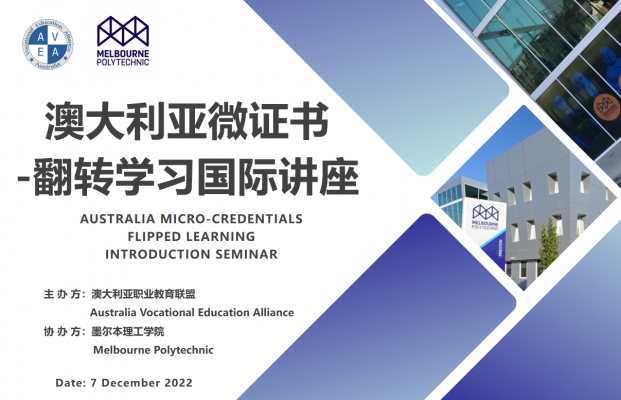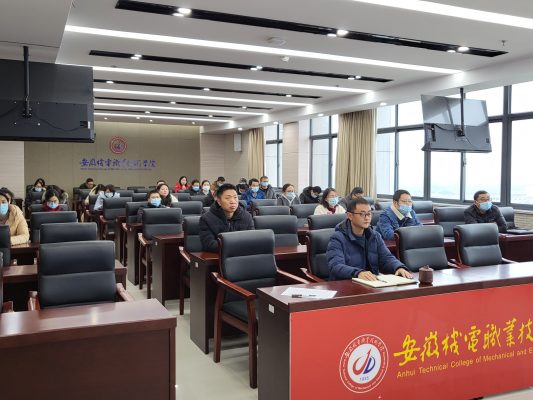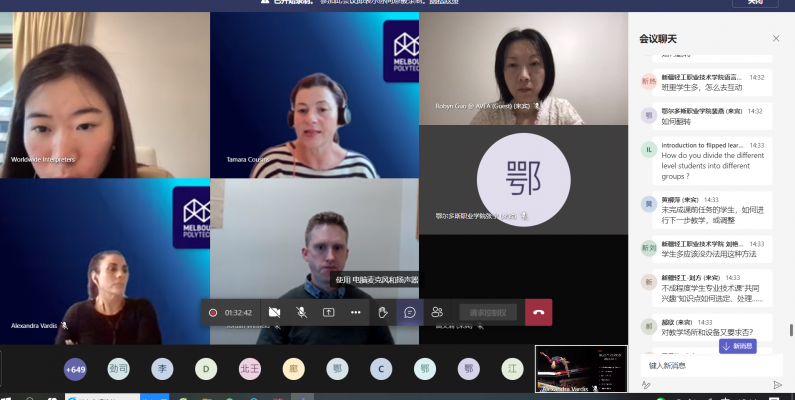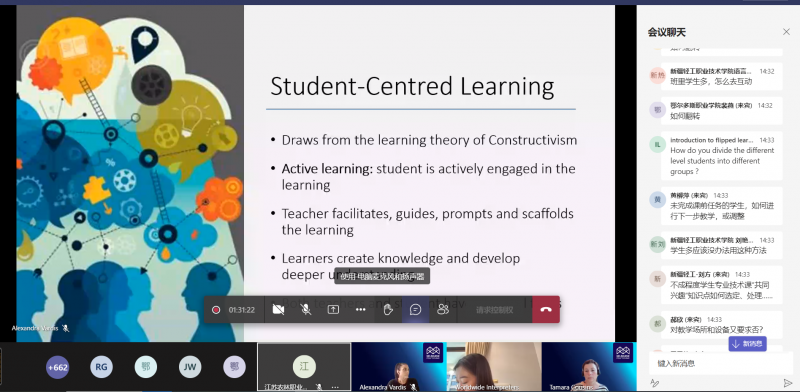
Currently online teaching becomes a regular method in colleges. The key issue is how to effectively implement online teaching and improve teaching effect. Flipped Learning is a very mature online teaching method and one of the micro-credentials in Australia, which could provide good guidance and reference for vocational colleges.
Therefore, Australia Vocational Education Alliance (AVEA) and Melbourne Polytechnic co-hosted an Australian Micro-Credential: Flipped Learning International Seminar and received registration from 21 colleges and institutions from Beijing, Jiangsu, Jiangxi, Guangxi, Henan, Xinjiang, Inner Mongolia, Anhui, with a total of 1029 participants.

Colleges and Institutions
Center for Language Education and Cooperation
Beijing College of Finance and Commerce
Beijing Polytechnic
Beijing Institute of Economics and Management
Beijing Polytechnic College
Beijing Business School
Beijing Jingsong Vocational School
Beijing Economic Management School
Beijing Changping Vocational School
Beijing Jinyu Polytechnic
Jiangsu Vocational College of Agriculture and Forestry
Anhui Technical College Of Mechanical and Electrical Engineering
Guangxi Economic and Trade Vocational Institute
Jiangxi Environmental Engineering Vocational College
Xianyang Vocational Technical College
Ordos Vocational College
Xinjiang Industry Technical College
Qinghai Qaidam Vocational and Technical College
Zhengzhou Health Vocational College
Anhui Institute of Information Technology
Chengdu Agricultural College
Yingkou Vocational and Technical College

01 Trainer Introduction
We’ve invited two trainers from Melbourne Polytechnic, Professor Alexandra Vardis and Professor Tamie Cousins.
Professor Alexandra Vardis is a member of professional teaching practice team in MP. She’s been an outstanding education since 2005, involved in lots of youth education projects as mentor and guidance, including Victorian Certificate Of Applied Learning (VCAL), Adult Migrant Education Program (AMEP), Young Adult Migrant Education Program (YAMEC) and so on. She has also been the leader of Youth Basic Education Program in MP. Professor Vardis believes that all students should have the opportunity to make achievements in education, regardless of their background or living environment. She guides and supports teachers to be more confident and experienced in Professional Teaching Practice (PTP) so that they can help their students to achieve certain learning goals.
Professor Tamie Cousins is also a member of professional teaching practice team in MP. She has 18 years teaching and innovative education experiences in middle school education, vocational education and higher education, moreover she has a deep knowledge of teachers’ teaching and training in particular. As a teaching trainer in MP, Professor Cousins works with teachers to support and develop their teaching practice through evidence-based teaching strategy. She’s also committed to the learner-centred approach that fosters learners’ engagement, curiosity and lifelong learning skills.
02 Highlights of the seminar
What is Flipped Learning?
Key words
- Blended learning
- Asynchronous and synchronous
- Independent online learning
- Scheduled face-to-face learning
Flipped learning is a form of blended learning that blends pedagogy with the use of digital technologies. It flips the traditional approach to classroom-based learning. Traditional learning is a centralized learning process, where everyone is gathered together (e.g. in a traditional classroom), and when everyone is separated, it is a process of knowledge internalization or consolidation. Flipped Learning, on the contrary, is individualized learning (asynchronous learning) where everyone is separated, but when they are together on a same online platform or in an activity organized by teachers (synchronous learning), they share and communicate to consolidate what they’ve learned.
Benefits of Flipped Learning
Key words
- Flexibility for the learner
- Active learning
- Deep learning
- Self-regulated learning
- Critical thinking
Teacher is designer of flipped learning. In the process of flipped learning, no matter it’s online or offline, we focus on creating an environment that supports students’ active learning. It is the flip of learning initiative from teachers to students, and the flip of learning content from knowledge transfer to knowledge creation.

Student-centred learning
Key words
- Draws from the learning theory of constructivism
- Active learning: student is actively engaged in the learning
- Teacher facilitates, guides, prompts and scaffolds the learning
- Learners create knowledge and develop deeper understanding
In traditional teacher-centred mode, teachers are the primary source of information. In contrast, flipped learning mode changes it to student-centred in which the task of a teacher is to guide students to learn. Class time dedicated to deeper communication and exploration so that students have more opportunities to engage in knowledge construction and express their interest and creativity.
Summary
Compared to traditional teaching method, flipped learning is a shift in the culture of learning and a shift in the roles of teachers and students. Teachers have to plan their class more carefully, apply student-centered, active learning methods and strategies, leading to rich and meaningful learning experience for students.
Good teaching is essentially an interaction between people in which stimulates students’ interest, enthusiasm and innovation. Only such learning methods as active, creative, interested, enthusiastic, exploring and constructive can truly make students love learning and achieve or even exceed the expected goal of teaching.



 简体中文
简体中文